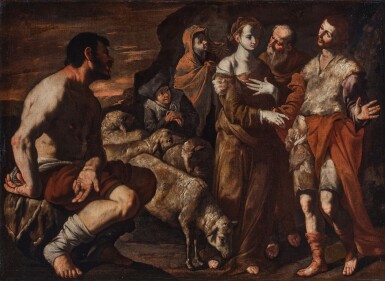Old Master & 19th Century Paintings Day Auction
Old Master & 19th Century Paintings Day Auction

Master of the Annunciation to the Shepherds
Meeting of Jacob and Rachel
This lot has been withdrawn
Lot Details
Description
Master of the Annunciation to the Shepherds
active Naples 1625–1650
Meeting of Jacob and Rachel
oil on canvas
unframed: 73 x 100.6 cm.; 28¾ x 39⅝ in.
framed: 95.6 x 123.2 cm.; 37⅝ x 48½ in.
Private collection, Valencia, by 1958;
Vittorio Frascione (1915–2006), Florence;
Thence by descent to his grandsons;
With Frascione Arte, Florence, by 2009;
From whom acquired, by 2013.
F. Bologna, Francesco Solimena, Naples 1958, p. 32 n. 7 (as Neapolitan School);
A.E. Perez Sanchez, Pintura italiana del siglio XVII en España, Madrid 1965, p. 373;
N. Spinosa in Le visioni di un grande collezionista; The Era of a Great Art Visionary, A. Nesi (ed.), exh. cat., Florence 2009, pp. 81–85, reproduced p. 83;
N. Spinosa in Ritorno al barocco, da Caravaggio a Vanvitelli, N. Spinosa (ed.), exh. cat., Naples 2009, vol. I, pp. 96–98, no. 1.27, reproduced;
N. Spinosa, Napule è... mille culure, Dipinti e disegni napoletani del XVII e XVIII secolo, exh. cat., Florence 2013, pp. 12–14, reproduced in colour pp. 13, 15;
N. Spinosa, Il Maestro degli Annunci ai pastori e i pittori dal "tremendo impasto (Napoli 1625–1650), Rome 2021, p. 59, no. A4, reproduced.
Naples, Castel Sant'Elmo, Museo Pigantelli and Palazzo Reale, Ritorna al barocco, da Caravaggio a Vanvitelli, 12 December 2009 – 11 April 2010, no. 1.27.
The Master of the Annunciation to the Shepherds, an artist working in seventeenth-century Naples, produced this work circa 1640. The naturalism, characterised by a realistic depiction of the figures’ physiognomy, dress and expression, is evidently influenced by Jusepe de Ribera, who similarly included everyday figures into his compositions conceived with dynamic brushwork.
Since the early twentieth century when August L. Mayer first identified the artist’s hand in an eponymous work in the Birmingham Museum and Art Gallery (fig. 1), scholars have offered various proposals as to the identity of the Master of the Annunciation of the Shepherds.1 These included the Brindisi-born Bartolomeo Passante (at times mistakenly conflated with Bartolomeo Bassante) who trained in the Neapolitan workshop of Pietro Beato and the Valencia-born Juan Dò, who trained under Ribera. However, the painter remains anonymous, though Nicola Spinosa has recently reconstructed his corpus, one defined by a broad use of impasto, earth tone palette, and dramatic use of chiaroscuro.
Within this compact composition, the artist depicts the Old Testament scene in which Jacob, wearing a sullied hair shirt at right, meets Rachel, who tends her father’s flock of sheep. Rachel would become Jacob’s second wife and bear him Joseph and Benjamin, two of the progenitors of the twelve tribes of Israel. Although extraneous to the narrative, a muscular shepherd at left sits nearly parallel to the picture plane, his angularly arranged physique rendered in dramatic relief. Both the shepherd and the sheep he tends reappear in several other of the painter's works, including the composition in Birmingham from which his name derives.
1 A.L. Mayer, Jusepe de Ribera (Lo Spagnoletto), Leipzig 1923, pp. 176–77; for a full account of the critical history, see Spinosa 2021.
You May Also Like










